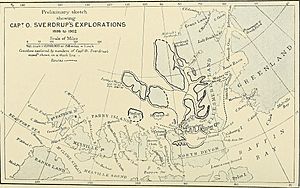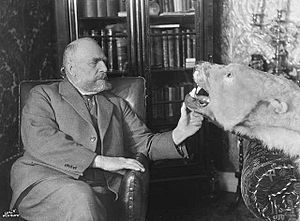Otto Sverdrup facts for kids
Otto Neumann Knoph Sverdrup (born October 31, 1854, in Bindal, Helgeland – died November 26, 1930) was a brave Norwegian sailor and Arctic explorer. He is famous for his important trips to the icy lands of the North.
Contents
Early Life and Becoming a Sailor
Otto Sverdrup was born in a place called Bindal. His father was a farmer. When he was 17, Otto moved to Nærøy to work with his uncle, who owned ships. This is where he began his life at sea.
He quickly learned how to sail and became very good at it. In 1875, he passed his mate's exam, which meant he could be a ship's officer. A few years later, he became a shipmaster, meaning he could command a ship.
Otto Sverdrup later met Alexander Nansen, who was the brother of the famous explorer Fridtjof Nansen. This meeting led to a friendship between Otto and Fridtjof Nansen, which changed Otto's life forever.
Adventures and Discoveries
Otto Sverdrup joined Fridtjof Nansen on his exciting trip across Greenland in 1888. This was a very challenging journey across the ice.
Later, in 1892, Sverdrup helped Nansen design a special ship called the Fram. This ship was built to handle the thick ice of the Arctic. In 1893, Sverdrup became the captain of the Fram.
In 1895, Nansen left the Fram to try and reach the North Pole on foot. Sverdrup was left in charge of the ship. He skillfully managed to free the Fram from the ice near Svalbard in 1896. He sailed the ship safely back to Norway, arriving just four days after Nansen himself returned.
Exploring the Canadian Arctic
In 1898, Sverdrup led his own big expedition with the Fram. He tried to sail around Greenland but couldn't get through a narrow passage called the Nares Strait. Because of this, he and his crew had to spend the winter on Ellesmere Island.
During this time, Sverdrup and his team explored and mapped many new areas on the western side of Ellesmere Island. They gave Norwegian names to many places, like Hoved Island ("main island").
Between 1899 and 1902, Sverdrup spent three more winters exploring the Canadian Arctic with the Fram. He discovered three new islands: Axel Heiberg Island, Amund Ringnes Island, and Ellef Ringnes Island. These islands are now known as the Sverdrup Islands.
Sverdrup and his crew learned from the Inuit people how to travel and survive in the Arctic. Using these methods, they mapped a huge area of 260,000 square kilometers. This was more land than any other polar explorer had mapped before! When Sverdrup returned to Norway, he was seen as a national hero.
Later Arctic Journeys
In 1914, Sverdrup went on a search-and-rescue mission in the Kara Sea. He was looking for two missing Arctic expeditions.
His fourth and final trip to the Arctic was in 1921. He commanded a group of five cargo ships on an experimental journey through the Kara Sea to the mouths of the Ob River and Yenisei rivers. All the ships reached their destinations and returned safely. This was a very important step in opening up the Northern Sea Route for shipping.
Later Life and Legacy
In his later years, Otto Sverdrup lived in Sandvika, Norway. He passed away in November 1930.
To honor his amazing achievements, statues of Sverdrup have been put up in Steinkjer (in 1957) and in Sandvika (in 1999). A square in Sandvika is also named after him, Otto Sverdrups plass.
In 2008, the Royal Norwegian Navy named one of their warships, the HNoMS Otto Sverdrup, after him. This shows how much he is remembered as a great mariner and explorer.
Sverdrup received many awards for his work. He was given the Grand Cross of the Royal Norwegian Order of St. Olav in 1902. He also received gold medals from important geographical societies. He even received an honorary degree from the University of St Andrews.
In 1917, Sverdrup showed his strong feelings about fairness. He returned an award he had received from Germany. He did this to protest against the way German submarines were sinking ships during World War I, which caused many Norwegian sailors to lose their lives.
See also
 In Spanish: Otto Sverdrup para niños
In Spanish: Otto Sverdrup para niños





